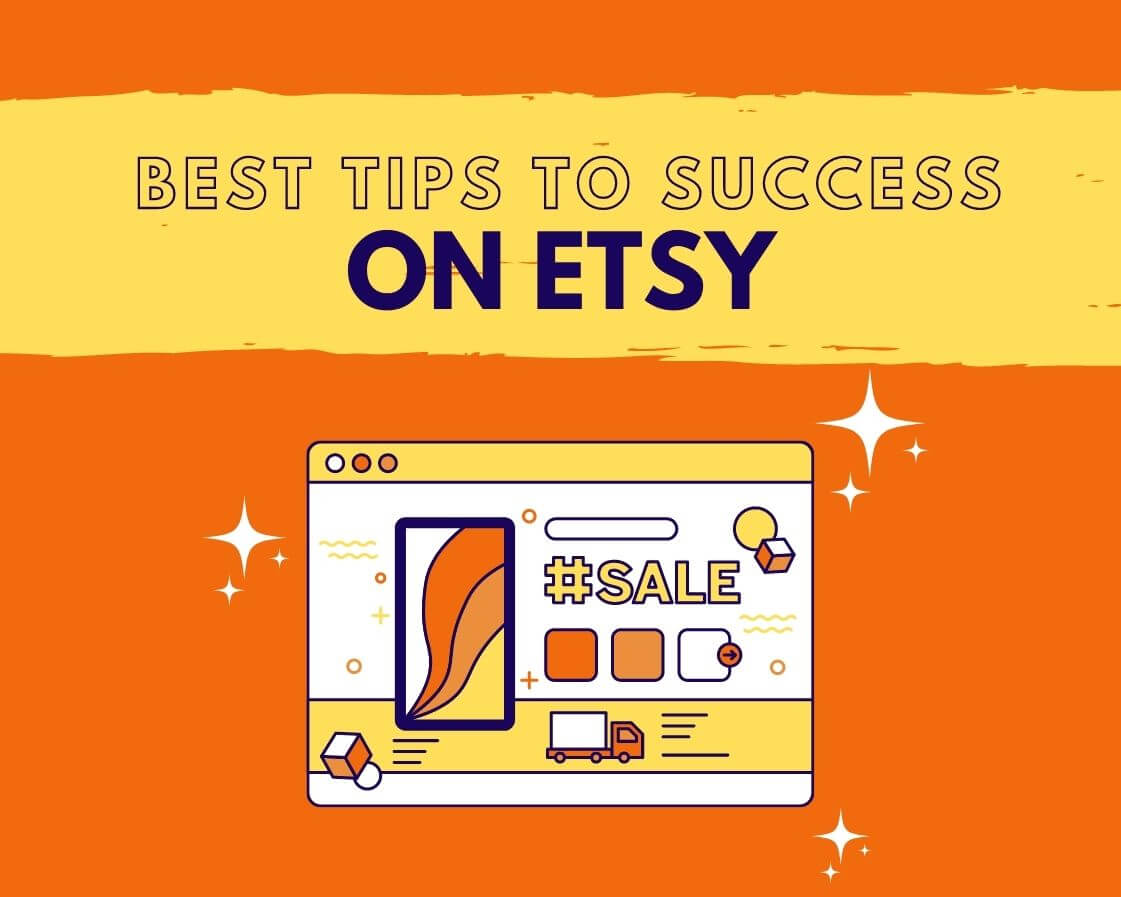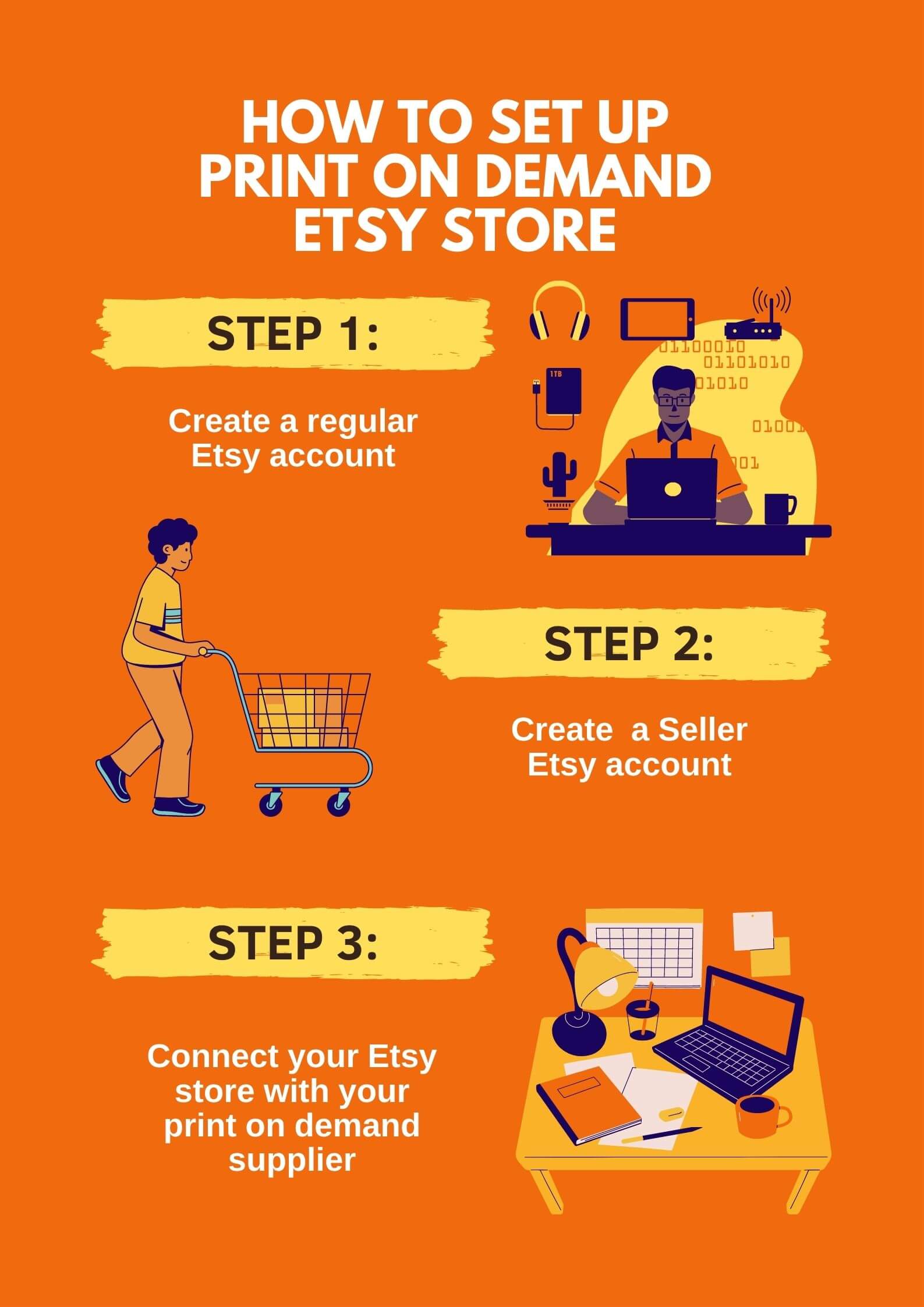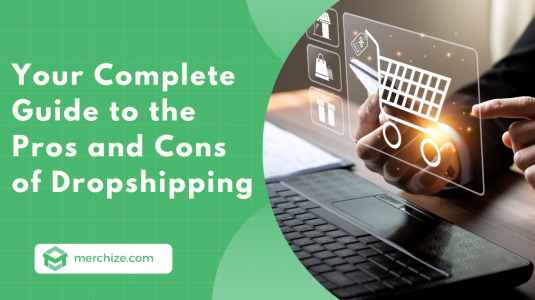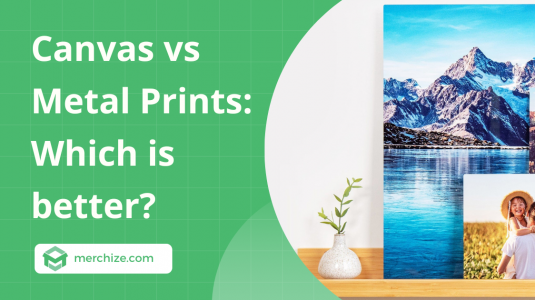Contents
Etsy has become a mecca for creative entrepreneurs and print-on-demand sellers. In fact, Etsy exceeded $13.16 billion in gross merchandise sales in 2023 alone.
But with over 25 million active Etsy buyers seeking unique, customizable products, how can you make your print-on-demand designs stand out?
Whether you’re just opening your Etsy shop or looking to refresh your product lineup, this article will walk you through the essential tips and strategies to optimize your print-on-demand business on Etsy. Let’s read on to take your Etsy print-on-demand shop to the next level!
Is Etsy good for print on demand?
Launched in 2005 as a place for selling and buying handmade, crafty goods, Etsy has exponentially grown into one of the biggest online retailers in the world. Last year, the number of active users on Etsy has increased to 81.9 million with currently 4.3 million sellers.
In the beginning, Etsy only accepted handmade items. In 2013, Etsy changed its policies and expanded its definition of handmade products to include a wider variety of products. Etsy now allows different forms of products as long as they are “made and/or designed by sellers”.
According to the new definition, print on demand is acceptable. And since 2015, Etsy started Etsy manufacturing that allows third-party manufacturers to integrate with their platforms and offer print on demand services to sellers on this ecommerce platform. It has created an opportunity for print on demand sellers to enter Etsy market and start selling print on demand products.
Nowadays, Etsy is one of the best platforms for print on demand businesses to flourish. Let’s see what are the advantages and drawbacks of selling print on demand on Etsy
Pros:
Market-fit platform for selling print on demand
Most Etsy customers choose this platform to shop mainly because this marketplace offers a plethora of one-of-a-kind products. And print on demand products can meet this particular demand of buyers on Etsy.
Print on demand products, to a certain extent, are original and limited as they are made in order, not mass-produced. Print on demand offers space for Etsy sellers to transfer their digital assets into physical products and gain money out of their skills and creativity.
Low maintenance fee
It is to register an Etsy account and start selling. It takes $0.2 to get your listing published on Etsy. Plus, Etsy charges 5% of the price on each sale. These are all the costs required to start selling print on demand on Etsy. The cost of Etsy is smaller compared to other major ecommerce platforms. And the growing popularity of Etsy also means that you can get more in return for what you paid for.
Tolerance of high-priced products
Another peak of selling print on demand on Etsy is that buyers on these ecommerce sites are willing to pay higher prices.
A survey done by Etsy in 2020 revealed that 88% of Etsy buyers agreed that this platform has items that you can’t find anywhere else. According to the law of scarcity, if we perceive something as limited in supply, its perceived value increases, which explains why Etsy buyers can be more generous in spending.
It creates an opportunity for print on demand sellers to increase their profit margins when selling on Etsy.
Cons:
Fierce competition
In 2019, the number of sellers on Etsy stood at 2.5 million. In the following year, this number nearly doubled, crossing the 4-million milestone. Such rapid growth in the number of sellers indicates increasing competition in this marketplace. It is estimated that this eCommerce market will get even more competitive in the future.
Limited option for building your own brand
Another con of Etsy is the limited option to establish your own brand. There is less room to customize the store, insert your brand identity, and raise brand awareness on this platform. Etsy only allows you to change your avatar and your store banner.
While there are a few drawbacks to Etsy, what this website can offer overshadows its lacking. It is still one of the best online marketplaces to sell print on demand.
Tips to set up your print on demand Etsy store
If you are ready to set foot on Etsy marketplace, the first thing you need to do is to set up your own store. No worry, it only takes a few steps to start selling and you will soon be all set to get your first sale.
How to make an Etsy account
To start selling on Etsy, you will need to create an Etsy seller account first.
- Create an Etsy account for regular users first
- Create Etsy Shop at Etsy.com/sell. Click “Get Started” button and you will be taken to the next screen where you will have to fill in the following information
- Set Shop Preference (Shop language, Shop country, Shop currency)
- Name your shop
- Add the first listing to your store
- Set up payment and billing details
- Set up two-factor authentication
After registering your shop, it’s time to set up the appearance of your storefront. At the moment, Etsy allows sellers to customize banners, shop logos as well as set up the About section, Shop policies, and Shipping profiles.
Etsy store setup tips for print on demand business:
One of the biggest challenges for print on demand business is quality control and long shipping time. Since the production and shipping process is handed over to the print on demand partner, it is out of your control.
Besides choosing a reliable print on demand supplier, it’s best to provide detailed and clear policies for refunds and cancellation as well as shipping profiles. It offers a safety net for your store and dictates your actions to handle disputes from unsatisfied customers.
Creating a FAQ section on your store is also helpful to guide your confused customers and improve the customer experience.
At this point, your print on demand shop is basically set up and ready to sell.
How to connect to your print on demand supplier of choice
If you’re set to sell print on demand products, there is still one more step to complete before you can start selling. In order to fulfill print on demand orders, you need to connect your Etsy to your selected production partner platform.
First, you have to set up your own account on the print on demand provider’s website.
After registering an account on your print on demand supplier’s website, you can connect your print on demand account to your Etsy store. The print on demand website will direct you to your Etsy’s account and ask for your authorization to connect to your store.
Once you allow the POD supplier to access your account, you can create listings from the POD site. Most of the print on demand companies offer a mockup generator that allows you to create product images easily and effortlessly.
Each time a listing is created from your print on demand website, it will be automatically synced to your Etsy store as a draft, ready to get published anytime.
On each listing, always remember to list your chosen print on demand supplier as your production partner so that every time an order comes in, it will automatically be updated to your print on demand supplier and get fulfilled.
Note that not all print on demand companies offer direct Etsy integration. Some Etsy integration would require technical skills in order to process. On the other hand, some print on demand providers might offer the CVS bulk importer tool – which means that you need to import your order file manually instead of an automated fulfillment process.
In other cases, like TeeLaunch for example, the print on demand partner only allows Etsy integration if you already run your own Shopify store.
Check out our list of top print on demand Etsy partners to know more about each print on demand Etsy integration’s pros and cons.
Tips to choose the best print on demand product for Etsy
After finishing up your storefront, the next step is deciding what products and designs you are going to put on your Etsy store. Now we will get to the best Etsy Print on Demand tips to find products for your print on demand Etsy store.
Find a niche
Putting your focus in a niche helps you have a better picture of your target customer base and makes your ideate process flow more efficiently.
On top of that, selling products for specific niches is the best way to avoid stiff competition. The supply for general products is saturated and mostly, they are dominated by strong competitors who have early starts. The only way to get around this harsh competition situation is to find less competitive niches.
In a market with high levels of competition, competitive pricing is what gets you ahead. Lowering your price also means cutting off your profits. On the contrary, Etsy customers are passionate about that specific niche and willing to pay to get the product that they can hardly find somewhere else.
Before start searching for niches, let’s see what defines a profitable niche?
- Low competition: It means that there are only a few products and sellers in that niche. The more crowded a space is, the harder it is for you to stand out. You can estimate the competition by examining the market first.
- Sufficient demand: Asides from having less competition, a niche can only be profitable if there is enough demand for it. Keyword search volume is a great indicator of the possible demand for a niche.
For more tips, check out our guide on how to find a niche for your print on demand store.

Follow the market trends
Besides doing niche research, another thing to keep on your radar is market trends. Your evergreen products can bring consistent sales to your store. However, don’t limit yourself to what you have already done well. Following what’s trending in the market can help you to keep up with the competition, explore business opportunities and gain more money. In the best scenarios, you can predict the trends and gain the advantages of first movers.
Trend research can also inform your design process, give you more ideas and inspiration. You can look for trendy colors, patterns, design styles, and products.
How can you find what’s trending in the market? Here are some places where you can get trend updates and assess a trend:
- Etsy Trend Report: Etsy also keeps updating its sellers on the latest trend on this platform. This is a reliable source for you to know what the customers on this platform are interested in.
- Google Trends: Google Trends is the most popular tool to detect what topics, events and keywords people are looking for on Google. By analyzing the huge search data gathered from the world’s most popular search engines, Google Trends can provide a pretty accurate overview of what people are interested in.
- Etsy tools: Besides the free resource mentioned above, there are also various paid tools that provide Trend report features. You can see what products and keywords are gaining attention from Etsy customers. Moreover, these tools also help you to analyze other Etsy stores and see the best sellers of those stores.
To succeed with print on demand and business in general, you should always be on the watch for the next big things.

Offer personalized products
“Personalized gifts” was the most searched keyword on Etsy in 2020. And this demand for personalized products is still growing. The latest market trend report released by Etsy suggested that there was a growth of 81% YoY in searches on this platform for personalized items.
It is unlikely that the preference for custom products is going away anytime soon. This is a huge opportunity that you should not ignore.
With print on demand, it is easy to offer personalized options for your customers. Try to incorporate some sort of personalization into your designs – your customers will be happy to spend some extra money on something uniquely theirs.

Choose a print on demand supplier with a wide range of products
Adding new products to your store is a good way to explore new business opportunities. Print on demand services are not limited to classic mugs, t-shirts, or hoodies. In fact, the print on demand industry is continuously developing, bringing a wide range of options for sellers to experience.
At the moment, the market for popular print on demand products like mugs or t-shirts is very saturated. The profit margin is lower and the competition is stiffer. In this situation, it makes sense to switch to other products that see less competition and offer more space to adjust your pricing.
How to find less popular print on demand products for your Etsy store?
Apparently, if you only use services from big and popular print on demand production partners, odds are a huge number of sellers are also accessing and selecting from the same pool of options.
In order to find unique, less common products, you should dig deeper and find new suppliers that offer a different range of products.
Here at Merchize, we have been working on expanding the variety of products for sellers. Check our full product catalog to find more unique products to add to your store.

Ready to create a successful Etsy print on demand shop? Click here for tips on etsy print on demand success.
Tips to sell print on demand on Etsy
After doing your research and knowing what products to add to your store, it’s about time to launch these products and promote them to potential buyers on Etsy. This is the most crucial part that determines the success of your Etsy store.
Create attractive images for your listings
Product image is the first thing that customers see when they encounter your listings. An attractive image will instantly capture the attention of the shoppers and help your products stand out from the vast variety of other products.
Images are even more important on platforms like Etsy where customers have keen eyes for aesthetic products. According to a survey conducted by Etsy, 90% of customers on this platform agree that image quality is “extremely important” to their purchase decision.
For print on demand sellers, delivering good photos for your listings can be a big challenge. Print on demand sellers do not store physical products. All products are manufactured and delivered remotely by the supplier. Plus, print on demand stores usually has a large collection of products that is updated frequently. It is a complicated and time-consuming process to get photos of actual products.

But don’t worry, there are a few tips you can follow to create attractive and convincing photography for your products.
Use various stock images for your mockup
Using the same stock image for a number of products can make your mockup look mass-produced and not trustworthy enough. Instead, add variety to the stock image folder – it will make your store’s collection more diverse and fun to look at.
Create lifestyle mockup images with human faces
This is particularly important with apparel products. A study shows websites with human images are positively perceived as more attractive, warm, and trustworthy. Plus, human faces are likely to attract the attention of online shoppers.
Order your best-seller products and have them photographed professionally: It is extremely hard to photograph all the products in a print on demand store. However, you can make some exceptions for the best seller products in your stores. Knowing that these products can actually sell, you can push the sales even higher by adding some great photos. It’s worth the investment.
Be consistent with your brand identity
Another pro tip for creating product images is to include elements of your brand identity into your photo. Etsy doesn’t allow much room for storefront customization and branding. In this situation, product images might be your fattest chance to introduce your brand and raise brand awareness. Don’t miss this opportunity to show your brand to your customers.
Make sure your mockup correctly represent your products
Statistics show that 22 percent of customers return the package because what they received looks different from what they ordered. You, as a seller, should make sure that the images correctly represent the real products to prevent miscommunication and lower the return rate.
Include key product information on your images
People can process and remember things better with images. If you want to emphasize something about your products for example sizes, variants, and usage details, you have better put the information in your product images. Chances are customers will notice and remember it better.
Write convincing descriptions
Product description is one of the key factors that influence buyers in making the purchase decision, along with product images and product reviews.
Here are a few tips to write a convincing product description for your Etsy store.
Include all important information about your product
According to a study by Nielsen Norman Group, 20% of the failed purchase could be attributed to “incomplete and unclear product information”. A well-written, informative product description can remove that barrier and increase your conversion rate significantly.
Put yourself in customers’ shoes to write a well-informed description. Ask yourself questions like what might confuse your customers and what they want to know about your product.
Keep your description short and sweet
It is important to be informative. But always keep your description clear and short. It has been proved that online users have short attention spans. Don’t try to burden their cognition load with too much information and walls of text.
Use a clear and scannable format
Structuring your description clearly helps customers easily follow the content and find the information they are looking for. Use bullet points to present key facts and features of your products.
Be conversational in your description
Remember that Etsy is a platform prioritizing independent sellers and small businesses. Your Etsy store does not represent a big corporation doing thousand- or million-dollar deals. So don’t be distant. Don’t use big words. Switch to a conversational tone when writing the production description.

Include keywords in your description
For Etsy’s ranking system, production description does not bear as much SEO value as other elements like titles, tags, and categories do.
That being said, it is regarded highly by Google’s search engine. Including important keywords into the product description might help boost the visibility of your listings on search engines.
When it comes to keywords, research what buyers are actually searching for on Etsy when looking for print-on-demand products. Some great keywords to target include:
- For posters/wall art prints: movie posters, band posters, travel posters, vintage posters, motivational posters, book posters
- For home decor: throw pillows, tapestries, blankets, shower curtains
- For apparel: t-shirts, sweatshirts, tank tops, baby onesies
- For stationery: wedding invitations, birthday cards, thank you cards, planners
- For phone cases: iPhone cases, Samsung Galaxy cases, phone grips
You’ll want to include exact match keywords (e.g. “cat poster") along with more broad and long-tail keywords (e.g. “decorative animal art prints").
Analyze your competition and look at what keywords other successful Etsy sellers are ranking for. Use Etsy’s keyword research tool to find high volume, low competition keywords.
And don’t just stuff keywords – make sure they are strategically placed in your titles, tags, and product descriptions. Highlight important keywords, repeating them where relevant. This optimization will help your products get found.
Set your price smartly
Getting strategic with your pricing is the key to winning the Etsy game. In the face of harsh competition, pricing can make or break your business.
With pricing, you want to remain competitive and reasonable while still maximizing your profit margins. Here are some practices you can apply to find that sweet spot.
Check your competitors
Competition is the biggest factor determining the retail price of your products. If the market is saturated and full of rivals, keeping your pricing on the affordable side is one way to beat the competition.
On the other hand, if there is little to no competition, it is completely fine to increase your profit margin.
Access your product’s strengths
It’s about how much value your product can offer. If you are confident that your products are original, of high quality, this can justify a higher price compared to your competitors.
Reversely, when your products possess no unique or valuable feature, it makes no sense to put up the price.

Find print on demand companies that offer good price
Lowering the base cost is one way to maximize your returns. Your base cost depends on the print on demand supplier you choose. Do your research and find a supplier that can offer a good price and high product quality.
Here is another pro-tip for you – Find new and small print on demand companies. These suppliers usually offer better pricing to attract sellers.
At Merchize, we also offer a wide range of products at a very competitive price that allows you to increase your bottom line.
> Read our blog: 15 Best print on demand companies and sites in 2021

Pay attention to your Etsy stats
Reading and analyzing stats can help you to understand and leverage your business. Undoubtedly, It is an essential skill that every business owner should have a good command of. On Etsy, store owners have access to all the key metrics of your store like visits, the number of orders, conversion rate, and your bottom line. Etsy Stats Tool also shows what sources and keywords are bringing traffic to your store.
Analyzing and comparing the metrics helps you access the performance of your listings. Based on this knowledge, you can make adjustments and improve your listings.

Offer free shipping
In a survey conducted by Etsy, 50% of the buyers said that they might abandon a product if the shipping cost is too expensive. Another survey published on Statista suggests 73% of online buyers in the US agree that free shipping can greatly influence their purchase decision.
The bottom line is that customers are enticed greatly by free shipping. Offering free shipping can remove the traction that prevents buyers from completing the payment.
You might wonder if buyers get free shipping then who is going to pay the shipping cost? Don’t worry, there is a way to go around this without paying for it out of your pocket.
Solution 1: Adding the shipping price to your retailed price
Basically, buyers are still paying for shipping. The shipping cost is included in the retailed price. Buyers can get free shipping at the expense of higher product prices. There is no loss from your end.
Solution 2: Offer free shipping if buyers spend a certain amount of money
This offering initiates customers to purchase more products, hence increasing your profits. The added profits can totally make up for the shipping costs you are paying.
For your information, in a 2020 survey, nearly one in two US customers claimed that they expected to spend from 30-50 dollars to get free shipping. You can refer to this standard to adjust your pricing and free shipping policy.

Solution 3:
Rather than offering straightforward free shipping, you can subtract the shipping costs to an acceptable rate and add the same amount to your final price. This way, you can minimize the cart abandon rate while keeping your pricing competitive.
Add multiple payment options
A recent report shows that 7% of potential customers leave their shopping carts without making a purchase because they are not given enough payment options.
Although online shopping is increasingly popular, some shoppers may still be wary of sharing their credit card information online.
Therefore, it’s crucial for your store to provide multiple payment options to cater to the needs of all customers.
Etsy offers a useful tool called “Etsy Payments" that enables sellers to accept various payment methods without having to open multiple accounts.
These payment options include credit cards, debit/bank cards, Etsy Gift Cards and Etsy Credits, PayPal, Apple Pay, and Google Pay.
By using Etsy Payments, you can avoid losing potential customers due to lack of payment options.
It’s also essential to consider in-person payment options.
Promote your store on social media
Social media is a powerful tool to draw potential customers to your Etsy store. With social media, your customer base is no longer limited to Etsy users. Showing up across social media allows you to approach new customers as well as maintain and nourish relationships with loyal customers.
In addition, social media platforms like Facebook or Instagram also allow you to strategically promote your products to your target audience through paid advertising campaigns.

Build your mailing list
Email marketing has a significant impact on online sales, with a whopping average return of $36 for every dollar spent.
This means it’s crucial for all business owners to have a strategy for building their mailing list right from the beginning.
However, this can be tricky for Etsy sellers as adding email addresses of people who bought from their store is not allowed under Etsy’s Terms of Use.
The best option is to create an opt-in form outside Etsy and promote it.
You can take several steps to build your mailing list while adhering to Etsy’s seller policy:
- Create an account with an email service provider like Constant Contact or Mailchimp that enables you to create a landing page for your opt-in form.
- Include the link to your landing page on your Etsy shop’s profile, about page, listing descriptions, and thank-you messages for recent buyers.
- Add the link to your shop banner, email signatures, and business cards.
It’s essential to have this strategy in place right from the beginning because you can’t send this link through Etsy Conversations or to any of your old customers without violating Etsy’s Terms of Use.
Always double-check the guidelines as they can change at any time.
Collect good reviews for your store
Statistics show that nine out of ten online buyers read reviews before making a purchase. In another survey by Namagoo, when asked “What makes a great online experience?”, 78% of respondents who are frequent online shoppers choose product reviews. It is the second most selected answer, just behind clear product images.
Reviews are particularly crucial for online businesses because the buyers can’t physically experience the products. The only way for them to evaluate the quality of your product is through other customers’ reviews.
If you think that authentic reviews should be organically received, you are mistaken. In fact, to collect reviews for your Etsy store, you should put in the work and be more strategic. Especially with new stores, it is very important that you take the initiative and ask customers to leave their feedback on your store.
- Here are some practices you can apply to get reviews for your Etsy shop.
- Send emails or messages to your customers to say thank you and politely ask for their reviews. Of course, this should be done once the package is successfully delivered in time, undamaged and the customer is happy.
- Include a thank you card on your package: This is an effective tactic to collect reviews. Telling your story can help you connect with the customers and convince them to leave positive reviews for your shop on Etsy.
At a small cost, many print on demand companies can make and insert cards into your package on your behalf.
Besides collecting positive reviews, you should also minimize negative feedback. Any unpleasant response from customers should be handled as soon as possible. Address these reviews politely and professionally in public. At the same time, send private messages to upset customers to see what can you do to reverse the situation.

Don’t be too upset about getting perfect full-star reviews. In fact, a majority of customers agree that less-than-perfect reviews appear more “authentic” to them.
At the end of the day, it is impossible to please everyone. Just around 95% is Ok.
Build relationships with your customers
Along with attracting new buyers, interacting and nurturing your relationship with existing customers is crucial to the future of your eCommerce business.
If customers remember and keep returning to your stores, it means you have successfully converted them into repeat customers. Let’s be real, a loyal customer base is the most valuable asset to any business.
They are highly valuable not just because of the actual monetary value they bring but also the power they hold in promoting your business. Growing this group of audience can help you save a lot of money putting into advertising and marketing in the long run.
Here are something you can do to make sure people will come back to your store:
- Keep customer service your priority
- Create loyalty programs or rewards for returning customers
- Connect with your customers and keep the conversation going via social media
- Work on your email marketing
- Take your customer’s opinions and feedback seriously
- Keep your loyal customers excited with new products

Keep learning from your competitors and the community
Even when you have successfully achieved stable revenue from your Etsy shop, never lose focus on your competitors and participate in communities of sellers. Always evolving and learning is the only way you can keep up with the constantly changing market.
By watching out for your competitors, you can learn what practices are working for them and whatnot. It helps you to develop your own strategy and adapt to the market.
Besides, engaging with people in the community keeps you updated on the latest news and market changes as well as seeing the bigger picture in the industry. Being in a community can also be a source of support for you. You can share your valuable experiences and consult people working in the same field.
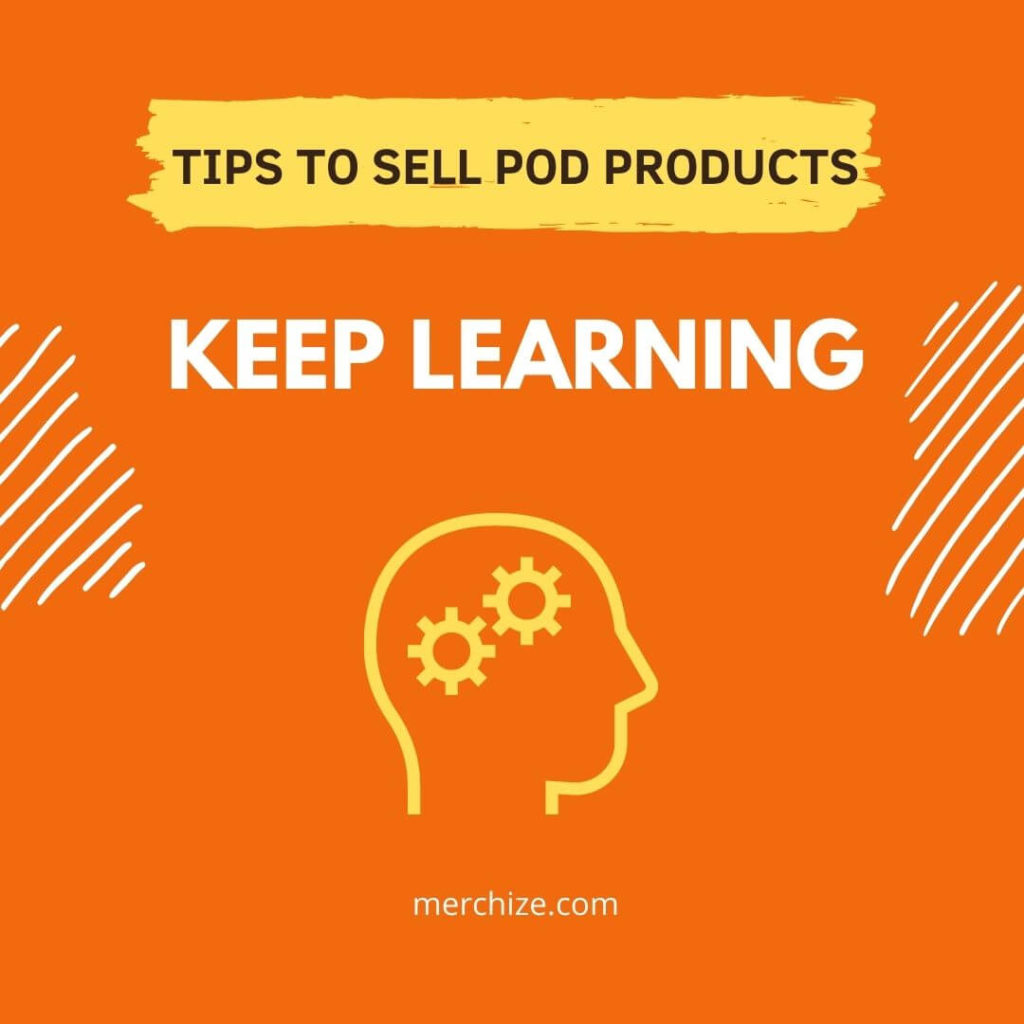
Key takeaways for Etsy Print-on-Demand success
If you want to build a thriving print-on-demand business on Etsy, keep these essential tips in mind:
- Optimize your titles, tags, and descriptions with relevant keywords so customers can find your designs. Conduct keyword research to identify high-volume, low-competition terms.
- Create eye-catching product photography on a budget using natural lighting, props, and editing apps like PicMonkey. Great photos attract more clicks and sales!
- Strategically price your products based on production costs, comparable items, and perceived value. Offer calculated shipping rates and free shipping guarantees to convert buyers.
- Take advantage of Etsy’s built-in traffic sources like promoted listings ads and special on-site events like Cyber Week.
- Analyze your shop stats and listings to identify top-performing products. Make more of what sells!
Following these tips will give you a proven framework for standing out from the competition and succeeding with print-on-demand on Etsy. Use this guide as a launch pad, then continue testing and optimizing your shop over time. With diligent research and quality execution, your custom designs can find an eager audience of buyers waiting to discover you.
The key steps are to choose profitable products, optimize your listings, take great photos, price smartly, and promote your Etsy shop. Put these tips into action to build your own stand-out Etsy print-on-demand business!
How much money can you earn through print on demand Etsy stores?
References:
1. Marina Pasquali, Number of active Etsy sellers from 2012 to 2020 retrived from https://www.statista.com/statistics/409374/etsy-active-sellers/
2. Marina Pasquali, Number of active Etsy buyers from 2012 to 2020 retrieved from https://www.statista.com/statistics/409375/etsy-active-buyers/
3. Etsy, Seller Policy retrieved from https://www.etsy.com/legal/sellers/
4. Etsy, 2020 Integrated Annual Report retrieved from https://s22.q4cdn.com/941741262/files/doc_financials/2020/ar/2020-Integrated-Annual-Report_final.pdf
5. Mary Kinney, Marketplace Insights: Early 2022 Trends retrieved from https://www.etsy.com/seller-handbook/article/marketplace-insights-early-2022-trends/1060546536815
6. Etsy, Why Product Photography Is Important, retrieved from https://www.etsy.com/ca/seller-handbook/article/why-product-photography-is-important/147451496051
7, Dianne Cyr, Bing Pan, Hector Larios, Exploring human images in website design across cultures: A multi-method approach
retrieved from https://www.researchgate.net/publication/228966707_Exploring_human_images_in_website_design_across_cultures_A_multi-method_approach
8, Stacey Rudolph, E-commerce Product Return Statistics and Trends [Infographic]
retrieved from https://www.business2community.com/infographics/e-commerce-product-return-statistics-trends-infographic-01505394
9, Jesse Mawhinney, 50 Visual Content Marketing Statistics You Should Know in 2021 retrieved from https://blog.hubspot.com/marketing/visual-content-marketing-strategy
10, Amy Schade, 3 Tips for Better Product Descriptions on Websites retrieved from https://www.nngroup.com/articles/product-descriptions/#:~:text=In%20our%20e%2Dcommerce%20studies,incomplete%20or%20unclear%20product%20information.
11, Etsy, Creating Listings That Convert
retrieved from https://www.etsy.com/seller-handbook/article/creating-listings-that-convert/366469719354
14, Ohad Hagai, Online Consumer Behavior Survey, retrieved from https://www.namogoo.com/resources/ebook/online-consumer-behavior-survey/
15, Trust Pilot, The critical role of reviews in Internet trust, https://business.trustpilot.com/guides-reports/build-trusted-brand/the-critical-role-of-reviews-in-internet-trust#downloadreport
